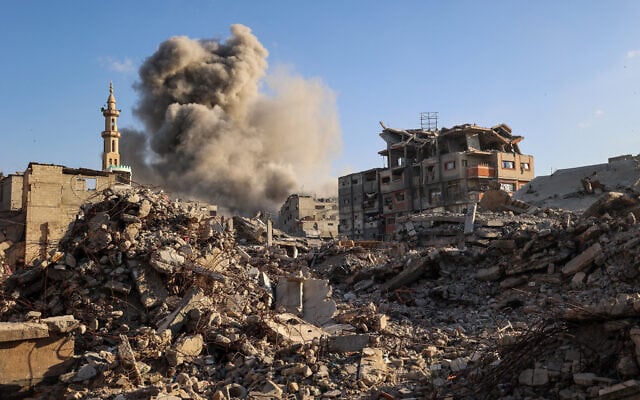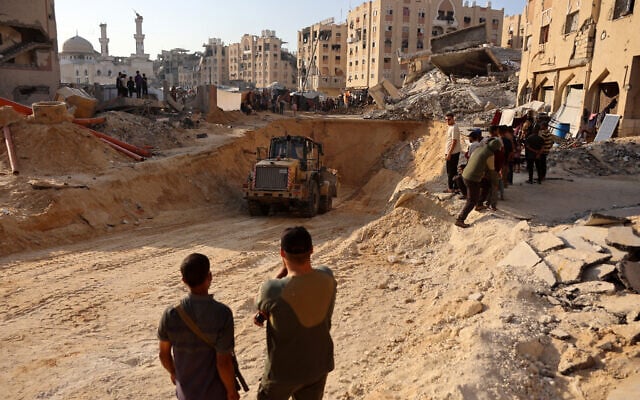The Israel Defense Forces announced on Sunday evening that two soldiers were killed and three were wounded in the attack by Palestinian terror operatives in Rafah during the morning hours. The military launched a wave of intense attacks on Hamas in response, with the violence leaving the fragile ceasefire teetering.
The slain soldiers were named as Maj. Yaniv Kula, 26, and Staff Sgt. Itay Yavetz, 21. Both served in the Nahal Brigade’s 932nd Battalion and were from the central city of Modiin. Kula was a company commander.
Israel blamed Hamas for the attacks, saying it was “a blatant violation of the ceasefire agreement.” However, the terror group said the incident occurred in an area under Israeli control, where they claimed to have had no contact with their operatives for months.
IDF Chief of Staff Lt. Gen. Eyal Zamir said troops would “remain on high alert.
“We are prepared and preparing for any scenario.” he said at a handover ceremony for the president’s military secretary.
The incident took place at around 10:30 a.m., in southeastern Rafah, close to the Salah a-Din Road. The area, east of the so-called Yellow Line, is under IDF control as part of the ceasefire deal with Hamas.
According to an initial IDF probe, a cell of terror operatives emerged from a tunnel in the area and fired RPGs at an excavator, killing the two troops. At the same time, another excavator was hit by sniper fire, wounding two more troops — heavy machinery operators — including one seriously and one moderately.
A short while after that, another soldier, also a heavy machinery operator, was moderately wounded by sniper fire, according to the army’s preliminary investigation.

The terror operatives did not attempt to abduct soldiers in the incident, the probe found.
The troops had been operating in the area — under Israeli control as part of the ceasefire — to clear it of Hamas infrastructure, with the assumption that gunmen could still be holed up in the terror group’s tunnels.
It marked the first deadly incident for the IDF in Gaza since the start of the US-proposed ceasefire, which began just over a week ago, aimed at ending two years of war.
In response to the attack, the Israeli Air Force and ground troops immediately carried out strikes in the area, hitting tunnel shafts and other infrastructure used by Hamas.
Later in the day, the IDF carried out a wave of dozens of strikes in southern and central Gaza, including against a major tunnel system previously used by Hamas to hold hostages.
Among the targets hit by fighter jets, drones, and artillery shelling were weapon depots, cells of operatives who were identified in “real-time,” and other infrastructure used by the terror group, according to the military.
The IDF said it also targeted Hamas operatives and field commanders in central Gaza. Palestinian and Arab media reported that a strike in central Gaza killed Yahya al-Mabhouh, a commander in Hamas’s elite Nukhba Force.
One airstrike carried out by fighter jets, which involved over 120 munitions, hit a major Hamas tunnel, spanning some six kilometers (some 3.7 miles), in the southern Gaza Strip, the military said.
According to the IDF, the tunnel was used by Hamas for advancing attacks on Israel, and it was previously used by the terror group to hold hostages.
The Hamas-run Gaza Civil Defense agency said that the strikes killed at least 21 people across the territory. The figures do not differentiate between civilians and gunmen.
In another incident on Sunday, several armed terror operatives were killed in a drone strike after they crossed the Yellow Line and approached troops near northern Gaza’s Beit Lahiya.
The IDF said the cell had “posed an imminent threat to the forces,” and therefore, “in accordance with the agreement,” a drone strike was carried out against the gunmen “to remove the threat.”
The army published a video of the strike.
מוקדם יותר היום, זוהו מספר מחבלים חמושים אשר התקרבו לכוחות צה"ל הפועלים במרחב בית לאהיא מעבר לקו הצהוב, והיוו איום מיידי לכוחות.
בהתאם להסכם, צה״ל תקף באמצעות כלי טיס של חיל האוויר, את המחבלים שחצו את הקו…
— צבא ההגנה לישראל (@idfonline) October 19, 2025
During the wave of strikes against Hamas, Israel temporarily halted the entry of aid into the Strip, as a precautionary measure, not a sanction, an Israeli official said. The aid was set to resume on Monday morning as usual.
The Rafah Crossing between Gaza and Egypt, which was set to open for the movement of Palestinians in both directions — not for the entry of aid — as part of the deal, would continue to remain closed until further notice, the official added.
Meanwhile, Hamas announced that a delegation led by Khalil al-Hayya, a leader in the terror group who resides outside the Strip, arrived in Cairo “to follow up on the implementation of the ceasefire agreement — with the mediators and with the Palestinian factions.”
Earlier in the day, the military wing of Hamas said it had found the body of another hostage during ongoing search operations.
“We will transfer the body today if the conditions on the ground are suitable,” it said, adding that “any Zionist escalation will complicate the search and digging operations and the recovery of the bodies, which will lead to a delay in the occupation’s receipt of the bodies.”

With the bodies of two hostages returned to Israel late Saturday, the number of bodies of captives still held in the Strip now stands at 16, out of the 28 that were there at the start of the current ceasefire.
The hostage deal reached earlier this month required Hamas to release the remaining 20 living hostages and the deceased hostages accessible to it within 72 hours of Israel’s October 10 withdrawal to the so-called Yellow Line inside Gaza.
In exchange, Israel has released nearly 2,000 Palestinian security prisoners and detainees, including 250 terror convicts serving life terms, plus the bodies of 15 Palestinians for every dead hostage returned from Gaza.
Hamas has said it would require additional machinery to locate the remaining deceased hostages. Israel has accused Hamas of lying, saying it can return almost all of the bodies.

